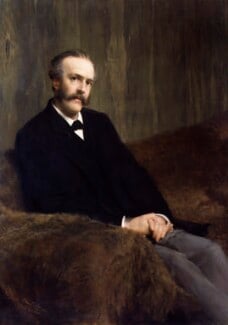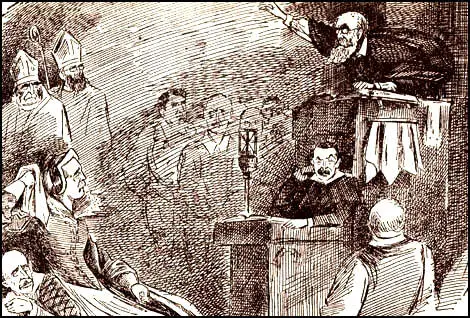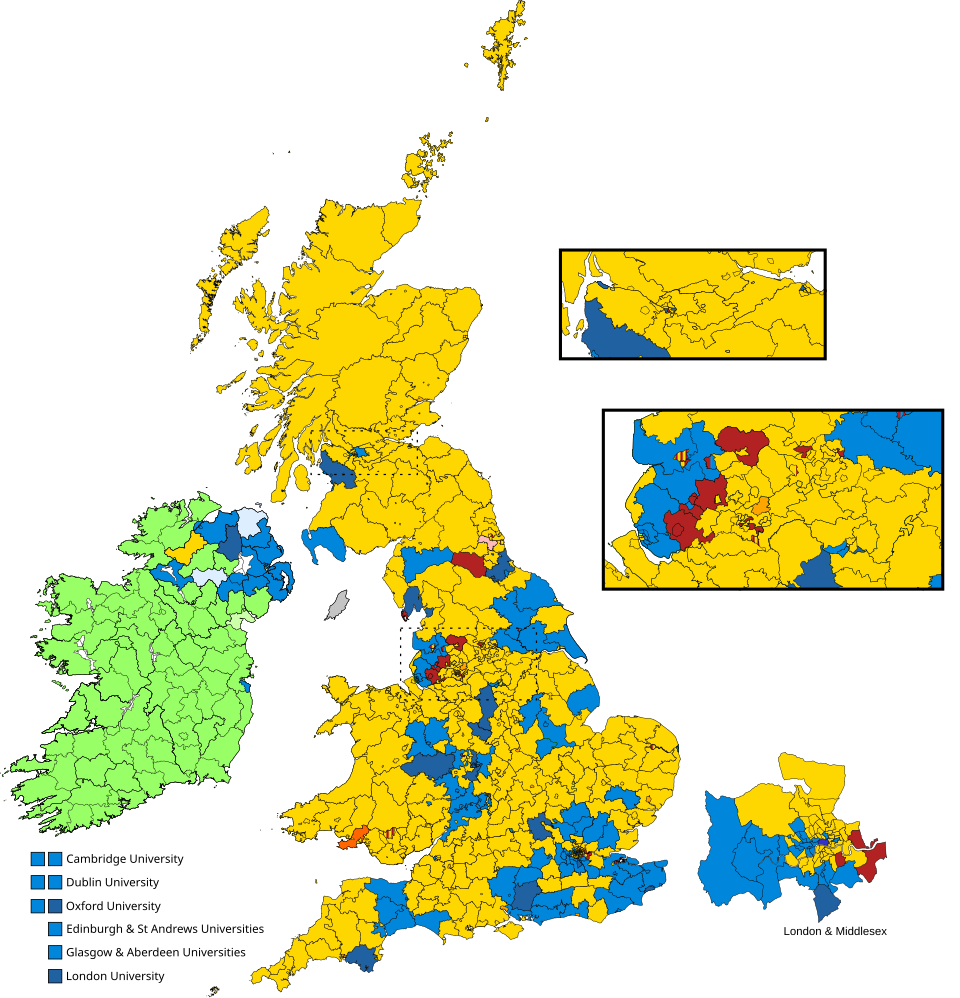OCR Specification focus:
‘The Conservative government under Balfour 1902–1905; reasons for the Liberal landslide.’
The Conservative Party’s decline under Arthur Balfour (1902–1905) and the resulting Liberal landslide of 1906 represented one of the most dramatic electoral shifts in British politics. Understanding these events requires examining Balfour’s government, Conservative weaknesses, external pressures, and the Liberals’ strengths.
Balfour’s Conservative Government 1902–1905
Leadership of Arthur Balfour
Arthur Balfour became Prime Minister in 1902 following Lord Salisbury’s retirement.

Balfour’s leadership framed the final Unionist administration before the 1906 electoral watershed. Source
His intellectual ability was recognised, but his leadership was often described as hesitant and aloof. His inability to unite different factions of the party weakened his effectiveness.
Balfour inherited a Conservative Party still strong in Parliament, but facing emerging challenges from industrial unrest, Irish issues, and growing debates about social reform.
His detached style led critics to see him as out of touch with popular concerns, particularly among the working and lower-middle classes.
Key Policies and Failures
The Balfour ministry passed some significant reforms, but many proved politically damaging:
Education Act 1902: Reorganised schools and increased central government involvement, but was deeply unpopular with Nonconformists, who resented having to support Anglican schools through rates. This alienated an important voting bloc.

Nonconformist leader Dr John Clifford became the public face of “passive resistance” to the 1902 Act. Source
Tariff Reform Debate: Joseph Chamberlain advocated for imperial preference (protective tariffs favouring empire trade), opposing the long-standing commitment to free trade.
This split the party into protectionists and free-traders, undermining unity.
Chinese Labour Controversy: The government allowed Chinese indentured labourers to work in South African gold mines after the Boer War.
Seen as “Chinese slavery”, this provoked outrage among workers and Nonconformists, who linked it to unfair labour practices at home.
Boer War Legacy: Although the war ended in 1902, it left bitterness over costs, military inefficiency, and alleged atrocities. The Conservatives gained little politically from what had been intended as a patriotic triumph.
Weakness in Party Unity
Balfour’s government became defined by disunity:
Tariff reform disputes divided MPs and even Cabinet ministers.
Alienation of Nonconformists due to education policy eroded previous cross-class appeal.
Balfour’s poor handling of industrial unrest and working-class concerns meant the party appeared indifferent to social reform.
Causes of the 1906 Liberal Landslide
Conservative Weaknesses
The Conservatives entered the 1906 election in a vulnerable state:
Unpopular policies: The Education Act and Chinese labour scandal alienated wide groups of voters.
Divisions: The party split over tariffs undermined electoral strength.
Leadership issues: Balfour’s perceived detachment and lack of charisma contrasted sharply with rising Liberal figures.
Liberal Strengths
The Liberals capitalised effectively on Conservative failures:
They presented themselves as the party of free trade, appealing to middle-class voters anxious about food prices.
They benefited from Nonconformist support, regained through opposition to the Education Act and moral campaigning against “Chinese slavery”.
Their policies resonated with emerging debates over social reform and national efficiency.
Support from Labour Representation
The recently established Labour Representation Committee (later the Labour Party) also played a role.
The Lib–Lab Pact (1903): An electoral agreement between the Liberals and Labour ensured they did not compete in certain constituencies.
This allowed the Liberals to maximise their challenge to the Conservatives, while giving Labour its first real foothold in Parliament.
Public Opinion and External Factors
The press widely criticised the government for arrogance and inefficiency.
Social and economic pressures (rising unemployment, industrial disputes) heightened calls for reform.
Nonconformist moral campaigns helped frame the Conservatives as both corrupt and unprincipled.
The 1906 General Election
Results
The Liberals won a landslide victory with 397 seats, compared to the Conservatives’ 156.

Constituency results illustrate the breadth of the Liberal sweep and the scale of Unionist losses across Britain. Source
The Irish Nationalists and Labour also increased their representation, highlighting the decline of purely two-party politics.
Consequences
The Conservatives entered a long period of electoral weakness, only recovering partially by 1910.
The Liberals, under Campbell-Bannerman and later Asquith, pursued policies of free trade, constitutional reform, and early welfare measures.
The result established the conditions for New Liberalism and the rise of the Labour Party, reshaping British politics.
Key Themes for OCR Students
Conservative Decline
Internal divisions over tariff reform.
Alienation of Nonconformists through the Education Act.
Public backlash over Chinese labour.
Leadership weaknesses of Balfour.
Liberal Landslide
Effective use of free trade vs. protectionism.
Alliance with Labour through the Lib–Lab Pact.
Support from Nonconformists and industrial workers.
Exploiting Conservative unpopularity over domestic and imperial issues.
Free Trade: An economic policy of unrestricted imports and exports, with no tariffs or duties, designed to lower prices and encourage international commerce.
The 1906 election stands as a watershed moment in British political history, marking both the collapse of Conservative dominance and the rise of a Liberal agenda more aligned with the social and economic challenges of the 20th century.
FAQ
Nonconformists had long supported local school boards, which allowed them to influence education outside Anglican control.
The Act abolished these boards and required ratepayers, including Nonconformists, to fund Anglican and Catholic schools through local taxation. This was seen as an attack on religious equality and conscience.
The result was widespread passive resistance, with Nonconformists refusing to pay school rates, fuelling anger towards the Conservatives.
The Taff Vale case (1901) ruled that trade unions could be held financially liable for damages caused during strikes.
This undermined the right to strike.
Employers gained leverage over unions.
Workers viewed the ruling as anti-labour.
The Conservative government refused to legislate to reverse the judgment, reinforcing perceptions of hostility towards working-class interests and driving many workers towards the Liberals and emerging Labour movement.
Newspapers amplified outrage over Chinese indentured labour in South African mines, using emotive language such as “Chinese slavery”.
Liberal-supporting papers framed it as immoral and un-British, appealing to Nonconformists and working-class voters.
Illustrations and political cartoons further inflamed criticism, portraying Conservatives as indifferent to ethical standards.
The scandal became symbolic of broader Unionist failings, making it one of the most damaging issues in the 1906 election.
Chamberlain’s resignation from Balfour’s Cabinet to campaign for Tariff Reform exposed deep rifts within the Conservative Party.
It highlighted divisions between protectionists and free-traders.
His stature as a major political figure gave the movement visibility and weight.
It forced Balfour into an awkward balancing act, alienating both sides.
The resignation transformed Tariff Reform into the defining issue of the election, ensuring Conservative disunity was visible to the electorate.
The pact ensured that in certain constituencies only one progressive candidate (Liberal or Labour) stood against the Conservatives.
This arrangement allowed Labour to focus resources on winnable seats and avoid wasted votes.
It resulted in Labour securing 29 MPs in 1906, a significant breakthrough.
At the same time, it strengthened the Liberals’ landslide by reducing competition on the anti-Unionist side, showing how electoral strategy contributed to Conservative defeat.
Practice Questions
Question 1 (2 marks)
Name two issues that weakened Balfour’s Conservative government between 1902 and 1905.
Mark Scheme:
1 mark for each correctly identified issue.
Acceptable answers include:
The 1902 Education Act and Nonconformist opposition.
The Chinese Labour controversy (“Chinese slavery”).
The 1904 Licensing Act.
The aftermath of the Boer War.
The Taff Vale judgment.
Divisions over Tariff Reform.
Maximum 2 marks.
Question 2 (5 marks)
Explain how the Tariff Reform debate contributed to the Conservative defeat in the 1906 General Election.
Mark Scheme:
1–2 marks: Simple description of Tariff Reform or mention of Joseph Chamberlain without developed explanation.
3–4 marks: Clear explanation of how the Tariff Reform debate divided the Conservative Party (e.g., free trade vs protectionists) and weakened electoral appeal.
5 marks: Developed explanation showing both internal party division and electoral consequences, such as:
Party split over Chamberlain’s proposals undermined unity.
Free Trade Liberals exploited fears of food price rises (“big loaf, little loaf”).
Divided Conservative message contrasted with clear Liberal stance.
Maximum 5 marks.

